In the last months, I have been in touch with Dr. Lee Jones, the early medieval sword enthusiast and collector (http://vikingsword.com). Our cooperation led to two articles published on these websites (see Private Sword with a Wooden Hilt and A Curonian Sword from a Private Collection). This time, Mr. Jones shared another interesting piece from his collection. This article will describe it, as well as the closest analogies, since it seems that the type is rather vaguely defined.
The sword owned by Mr. Jones.
The sword owned by Mr. Jones
The sword, that can be seen above, belongs to Mr. Lee Jones “for several decades” and was probably bought in an auction or at Ebay as other swords in his collection. As far as we can judge, it seems to be a genuine piece that shows the application of original technology.
In the current state, the sword is 676 mm long and weighs 531 grams. The iron blade, which is in poor condition with severe losses, is 540 mm long, 36.8-25.0 mm wide (36.8, 33.3, 29.9, 27.9, 26.8, 25.0 mm taken at roughly 100 mm intervals) and 5.2-3.5 mm thick (5.2, 6.4, 3.8, 4.7, 4.1, 3.5 mm taken at 100 mm intervals). The blade seems to be somewhat lenticular in cross section; towards the hilt the remain is thickest at the midline, proceeding towards the tip the faces of the blade become fairly flat. If the corrosion is hiding a fuller, then it must be quite shallow. There is no evidence of pattern welding or inlays.
The hilt is 136 mm long in the mid-line. The upper part of the hilt is formed by the five-lobed pommel and adjacent upper guard that are each cast in copper alloy. As they are loose, we can see they are semi-hollow castings. The intended display surfaces are smooth and in very good condition. The pommel is 65.6 mm long, 28.9 mm high (central lobe; 19.4 and 18.6 mm for intermediate lobes, 10.8 and 10.5 mm for outer lobes) and 18.9 mm thick (central lobe; 16.4 and 16.0 mm for intermediate lobes, 13.0 and 12.2 mm for outer lobes). The thickness of the wall of the pommel varies from 2.8 to 5.0 mm at edge. The upper guard of concavo-convex shape copies the curvature of the pommel. There is a raised ridge line on the surfaces of the guard. The length of the upper guard is 74.0 mm, while it’s height is 8.7 mm and the thickness 20.5 mm (central; 14.6 mm peripheral). The grip area tang shows no traces of organic material. The tang in that area is 88 mm long, 17.0-10.0 mm wide (17.0 mm at cross-guard, 12.9 mm mid, 10.0 mm at pommel) and 5.1-4.2 mm thick (5.1 mm at cross-guard, 4.9 mm mid, 4.2 mm at pommel). The curved, convexo-concave cross-guard is of iron showing moderate corrosion; the scale and cross section are consistent with the upper guard and in one place there is a suggestion of a ridge line. The cross-guard is 106.6 mm long. The height of the cross-guard is 24.1 mm (greatest extent including the arc), or 8.9-11.2 mm (8.9 and 9.3 mm peripheral, 11.2 mm central), if the arc is not taken in account. The thickness of the central part of the cross-guard is 17.3 mm and it continuosly tapers to 12.9 / 14.5 mm in the middle and 9.8 / 10.4 mm at the ends.
Broader perspective
The sword of Mr. Jones is quite rare and the searching for close analogies is not possible without difficulties. Especially the cast 5-lobed pommel seems to be almost absent in the literature. Before anything else, let us describe the sword from the perspective of current sword typologies.
Petersen’s typology
The sword type with curved guards and peened 5-lobed cast pommel is not present in Jan Petersen’s typology (Petersen 1919). However, there are some types that stand very close to the sword owned by Mr. Jones. 15 types or variants of Petersen’s typology (main types L, O, K, Q, T, X, Y, Z, Æ; special types 7, 14, 15, 16, 17, 18, 19) apply the curved cross-guards, from which at least 12 types or variants (main types L, O, P, Q, Y, Z, Æ; special types 7, 14, 15, 16, 19) use curved cross-guard and curved upper guard/pommel at the same time. At least 5 types or variants (main types L, O, Z; special types 14, 19) use curved cross-guards, curved upper guards and lobed pommels at the same time.
There are at least two Petersen hilt types that use components cast in copper alloy: type O and type W. At least four Petersen’s types or variants (K, O, R, S) apply 5-lobed pommels connected to upper guards by two rivets or a semicircular rivet. Specifically, a 5-lobed variant of types R and S have a very similarly looking pommel. However, none of these four types or variants uses the construction with the peened tang. From a construction point of view, the closest types are L and Z, as they use curved cross-guards, curved upper guards and lobed pommels that are sometimes peened. Moreover, the general shape of the pommels of these types is quite close to the pommel of the sword owned by Mr. Jones. Even there is no identical example in Scandinavia, this approach of searching for analogies tells us there was a tendency to use mentioned features in Europe of 10th and 11th century.
Petersen’s typology, vizualized by Jones 2002: 18-19.
Jakobsson’s design principles
Swedish archaeologist Mikael Jakobsson (1992) arranged Petersen’s types into 6 so-called design principles, the larger groups of hilts that use the same features, and enriched Norwegian-centric Petersen with many useful distribution maps. In this context, we will mention the principle 2, 3 and 5.
Design principle 2 represents 3-lobed pommels, including also types L and Z. According to Jakobsson, this principle can be dated between late 8th and early 11th century and it contains no less than 26% of European swords. The principle is widespread across the Europe; 37% of examples come from Norway, 12% from Sweden, 9% from Finland, 4% from Denmark, 15% from Western Europe and 23% from Eastern Europe.
The principle 3 is described as a group of swords that use 5-lobed pommel. According to Jakobsson, this principe is the least frequent, counting just 5% of European early medieval swords. 49% of examples were found in Norway, 5% come from Sweden, 30% from Western Europe and 15% from Eastern Europe. Jakobsson undestands principle 3 as a development of the principle 2 and the usage can be dated to period between early 9th and mid 10th century in Scandinavia.
Design principle 5 comprises swords with curved cross-guards. Swords with this feature represent 26% of early medieval European swords. In Scandinavia, they can be dated to the period from early 9th to late 11th century. 71% of examples come from Norway, 7% from Sweden, 5% from Finland, 1% from Denmark, 10% from Western Europe and 6% from Eastern Europe.
The sword of Mr. Jones can be described as a sword that belongs to design principles 3 and 5. More or less close analogies can be found in all three named categories. The advantage of Jakobsson’s work lies in the fact that he maps the bigger groups of swords within Europe.
Jakobsson’s design principles, taken from Jakobsson 1992: 27, Fig. 1.
Wheeler’s typology
In his book, Sir Mortimer Wheeler described 7 Scandinavian hilt forms that occur in Britain (1927: 31-37, Fig. 13). Even though it rather reduces the actual reality, it is still being used by British academia. The sword of Mr. Jones stands close to Wheeler’s type V and VI, which visually corresponds to Petersen’s types L and Z. Type V is said to have very curved guards and a peened pommel with a big central lobe, while type VI has slightly curved guards and 3-lobed pommel that is riveted to the upper guard. Type V is therefore a closer choice. The final remark of this section is that swords of the British origin are imprecisely categorized, leading to the constant need of classifying uncommon swords as variants.
Wheeler’s typology, taken from Wheeler 1927: 32, Fig. 13.
Geibig’s combination typology
German scholar Alfred Geibig presented his study on early medieval blades and hilts in 1991 (Geibig 1991). His typology of hilts, which comprises of combination of differently shaped hilt components, is based upon detailed study of several hundred swords from what is now Germany. The book made Continental corpus accessible and the careful and precise work led to conclusion that it is considered to be one of the most solid studies in the field. Geibig classified 19 combination types, dated to the period between 9th and 12th century.
The combination type 7 describes the form of the hilt that is visually identical with the sword of Mr. Jones. According to Geibig, the 5-lobed pommel rests at the pommel guard and both these components are attached by the exposed peened tang. According to Geibig, this combination type is equal to Petersen’s type L, even though there is a little different shape of the cross-guard: type L cross-guards are more pointed from the top view, while combination type 7 cross-guards are rounded.
Geibig’s combination type 7, taken from Geibig 1991: 47, Abb. 8.
Cast pommel : the identification problem
The sword might seem to a closed case with the result it belongs to type L. The problem occurs when we realize that cast pommels do not belong to Petersen’s type L swords. In the most recent article about Petersen’s type L swords (Aksdal 2017), there is no mention about copper alloy pommels. I have contacted the Mr. Jostein Aksdal, the author of the article, asking him for definition of the sword. His response was that the curvature of the pommel and attachment correspond to Petersen’s type L, but the presence of cast components and 5-lobed pommel prevent the sword to be labelled as Petersen’s type L sword. Mr. Aksdal suggested the sword could be what he calls “British version of type S”. His final conclusion is worth of quoting:
“My experience is that Viking Age sword chronology needs more detailed studies, identifying sub-types and local-regional types of swords from the Viking Age.“
Therefore, we should follow this advise and have a look what the British archeological material has to offer.
An analysis
To our surprise, the material is quite impressive and offers good analogies, but it is poorly described as a whole. We will try to mention the swords that have curved guards and 5-lobed pommels. A closer attention will be given to cast elements.
Swords already labeled as Petersen’s type L
To contradict the Mr. Aksdal’s argumentation, we have to state there already are swords with cast components and 5-lobed pommels in his own article, classified as Petersen’s type L swords. In the museum of Norwich, a decorated 5-lobed sword pommel cast in bronze is stored (Bjørn – Shetelig 1940: 61; Davidson 1962: 55-56). The pommel is classified as a part of a Petersen’s type L sword (Aksdal 2017: 87, Catalogue B:26). The second example is the sword from Surrey (1996.0604.1; British museum 2018), which has 5-lobed pommel and guards cast in bronze. Again, the sword is categorized as Petersen’s type L by Mr. Aksdal (2017: 87, Catalogue B:34). To be fair, these pommels are rather asymetrical and their lobes are more pointed, compared to the sword of Mr. Jones. To sum up, the sword from Surrey still represents one of the closest analogies.

The pommel from Norwich (left) and the sword from Surrey (right).
Taken from Davidson 1962: Fig. 41a and British museum 2018.
The distribution of type L swords in Great Britain.
Aksdal 2017: Fig. 8.
Loose cast pommels
Searching for loose cast pommels, we have found 97 examples dated to 9th-12th century Britain. We can divide them between several types according to their construction and general shape:
- pommel attached to the upper guard, without exposed peened tang
- Petersen’s type O (Petersen 1919: 126-134) / Geibig’s combination type 9 (Geibig 1991: 50-52, Abb. 10)
- Petersen’s type R (Petersen 1919: 140-142) / Wheeler III (Wheeler 1927: 34, Abb. 13:3)
- pommel attached to the upper guard, with exposed peened tang
- lobed
- with curvature
- without curvature
- not lobed
- with curvature
- without curvature
- lobed
- one-pieced pommel with exposed peened tang
- Petersen’s type K (Petersen 1919: 105-110) / Wheeler IV (Wheeler 1927: 34, Abb. 13:4) / Geibig’s combination type 6 (Geibig 1991: 44-47, Abb. 7)
- Petersen’s type L or Z (Petersen 1919: 112-121, 175-177) / Wheeler V or VI (Wheeler 1927: 35, Abb. 13:5-6) / Geibig’s combination type 7 (Geibig 1991: 47-48, Abb. 8)
- Petersen’s type X (Petersen 1919: 158-167) / Geibig’s combination type 12 (Geibig 1991: 56-60, Abb. 13)
- Geibig’s combination type 14 and 15 (Geibig 1991: 63-70, Abb. 15-16)
Distribution of loose cast pommel from 9th-12th century in Britain.
Click the map for an interactive Google Map.
As we can see, cast pommels were used for various typologically and chronologically different hilts, and therefore we can speak of a kind of tradition. The tradition is more obvious when we realize that cast pommels occur in the period from the earliest phase of Anglo-Saxon period to at least High Medieval. 95 pieces are made of copper alloy, 1 piece is cast in lead. The pommels depicted on our map are loose, found separated from the sword or just with a fragment of tang, which is also striking. According to Anglo-Saxon living history expert Paul Mortimer, such a big number is not coincidence and the pommels could be violently torn off during a ritual destruction, for example.
We can also notice that lobed curved pommels attached to upper guards with exposed peened tang represent a majority of the loose pommel. On the map, there are 61 finds that are mostly concentrated in East and West Midlands, East of England, Yorkshire and the Humber and South East England regions. This distribution corresponds to the distribution of Petersen’s type L swords quite well. There are at least two more pommels of this form in the private collection of Mr. Justin Mercier. This kind of popularity can mirror the fact that hollow upper guards and pommels peened to the tang could be done more easily than other types of constructions. It is surprising there are such an huge amount of sword pommels that are not described in the literature. On the website of Portable Antiquities Scheme, the pommels of this type are described as croissant-shaped pommels, Petersen’s type L pommels or Wheeler’s type VI by contributing editors.
The regular lengths of type 2.1.1. pommels are 44.8-65 mm, while the maximum height reaches from 20.6 to 32.2 mm. The pommels have thicknesses of 14-23.7 mm; the thickness of the casing is 2-5 mm. The weight is around 27.4-77.55 g (some heavier pieces include fragments of tangs). The pommel of the Mr. Jones’s sword is slightly longer, but other dimensions do match precisely.
Loose cast pommels of the type 2.1.1. The source of the pictures: PAS.
See the full resolution here.
Loose cast guards
In addition, we can shortly discuss the cast guards. In the following list, we have collected 7 cross-guards and 15 upper guards cast in copper alloy in 9th-12th century Britain. The following division was made:
- Cross-guard (7 pieces)
- Upper guard
- Guard with curved upper part (12 pieces)
- Guard with straight upper part (3 pieces)
Distribution of loose cast guards from 9th-12th century in Britain.
Click the map for an interactive Google Map.
Again, copper alloy components are distributed across the same regions. Regarding the cross-guards, every piece is unique. The number of cross-guards is lower that the number of upper guards, which may suggests that the cast cross-guards could have been used less often. That could correspond with the fact that the sword of Mr. Jones combines an iron guard and a cast upper guard and pommel.
The upper guards are divided to two categories. The category 2.1. is the most interesting for us, as the upper guard of the examined sword falls into this group. The most of guards in this category were dated to Late Middle Ages by the PAS website, but we believe this is incorrect. Not only two finds are dated to Early Medieval period, but they closely resembles the type L upper guards in shapes, proportions and sizes (see for example Aksdal 2017: Tab. 1-2). In this group, we can find curved and mostly hollow guards with a small rectangular hole for the tang. They are 56.78-87.7 mm long, 6.54-21.05 mm high and 9-22 mm thick. The guard of Mr. Jones’s sword fits in these categories. However, there are also some difference: the ends of guards are not flattened and there is no evidence of the central raised ridge line.
The upper guard of Mr. Jones’s sword is 74 mm long, while the pommel is 65.6 mm long, so the difference in lengths is 8.4 mm. We have already told that the length of loose pommels varies between 44.8-65 mm. In proportion to loose upper guards, the difference is 11.98-16.54 mm. The thicknesses of loose components are comparable (14-23.7 mm : 9-22 mm). The future examination can reveal whether the loose pommels and loose upper guards do fit or not.

Loose cast upper guards. The source of the pictures: PAS.
See the full resolution here.
For the next part of the analysis, we have to ask whether there is any complete sword that applies curved guards and peened cast 5-lobed pommel.
Wallingford Bridge type
In 1967, Vera Evison published an interesting study about an unmapped type of Anglo-Saxon swords that stand close to Petersen’s type L and Z (Evison 1967). The main feature that differentiates this type from Petersen’s is a differently shaped guard. Mrs. Evison called the examined group Wallingford Bridge sword type and suggested they were made in souther England in 10th-11th century. Even though there are only 9 examples in England (7 of which were found in the River Thames) and they rather resemble Petersen’s type Z / Wheeler’s type VI when it comes to the construction, we believe the study is an important step forward to show the complexity of local and transitional variants. If the concept is correct, then the sword of Mr. Jones and the pommels of the type 2.1.1. stand between Petersen’s types L, S and Z, not only by the form, but also by the chronology, just as Wallingford Bridge type does. Generally speaking, type L is the closest and it should be legit to call Mr. Jones’s sword type L variant until a more precise typology is invented.

Wallingford Bridge type swords (Evison 1967: 162, Fig. 1).
In the Evison’s article, we can find a reference to the sword from Mileham, which seems to be a second close analogy to our sword (Evison 1967: 185, Fig. 3b, 6a). This sword has copper alloy hilt components, including a richly decorated guard and an one-pieced pommel of our type 3.2. To our knowledge, there are no closer published paralels of Mr. Jones’s sword than swords from Surrey and Mileham. Therefore, the sword of Mr. Jones can be called unique in that regard.
The sword from Mileham (Evison 1967: Fig. 3b, 6a).
Auctions
In 2012, a discussion about loose cast 5-lobed pommel arised on MyArmoury.com. Shane Allee, a member of the forum, posted a picture of the sword, that was sold on Ebay more than 15 years ago. The sword seems to belong to the same type as Mr. Jones’s sword. However, we do not have any particularised information about the sword.
The sword sold on Ebay.
Conclusion
In the first part of this article, we tried to describe an unusual sword from a private collection. The uniqueness of such a sword led us to a type that stood aside completely unnoticed. The closest analogies were found in 10th-11th century Britain, a country where the mixture of styles created a variety of transitional swords that apply different constructions, shapes and materials altogether. Nevetherless, it will require a brilliant mind and a huge time reserve to arrange the swords in a realistic way.
I hope you liked reading this article. If you have any question or remark, please contact me or leave a comment below. If you want to learn more and support my work, please, fund my project on Patreon or Paypal.
Stone carving from Eberston, Britain. Taken from Grove 1938: 256, Fig. 5.
Bibliography
Aksdal 2017 = Aksdal, Jostein (2017). Dei anglosaksiske sverda : L-typesverd i England og Skandinavia. In: VIKING – Norsk Arkeologisk Årbok, Vol: LXXX, 59–88.
Bjørn – Shetelig 1940 = Bjørn, Anathon – Shetelig, Haakon (1940). Viking Antiquities in Great Britain and Ireland, Part 4 : Viking Antiquities in England, Bergen.
British museum 2018 = Sword from Surrey, Shepperton, Museum number 1996,0604.1. Electronic source, http:// www.britishmuseum.org/research/collection_online/collection_object_details.aspx?objectId=84 887&partId=1&searchText=1996,0604.1&page=1, visited 31th October 2018.
Evison 1967 = Evison, Vera I. (1967). A Sword From the Thames at Wallingford Bridge. In: The Archaeological Journal 124(1): 160–189.
Davidson 1962 = Davidson, Hilda R. Ellis (1962). The Sword in Anglo-Saxon England. Its Archaeology and Literature, Oxford.
Geibig 1991 = Geibig, Alfred (1991). Beiträge zur morphologischen Entwicklung des Schwertes im Mittelalter : eine Analyse des Fundmaterials vom ausgehenden 8. bis zum 12. Jahrhundert aus Sammlungen der Bundesrepublik Deutschland, Neumünster.
Grove 1938 = Grove, L. R. A. (1938). Five Viking-Period Swords. In: The Antiquaries Journal, 18(03): 251–257.
Jakobsson 1992 = Jakobsson, Mikael (1992). Krigarideologi och vikingatida svärdstypologi, Stockholm : Stockholms Universitet.
Jones 2002 = Jones, Lee A. (2002). Overview of Hilt & Blade Classifications. In: Oakeshott E. – Peirce, I. G. (eds). Swords of the Viking Age, Woodbridge: 15–24.
Petersen 1919 = Petersen, Jan (1919). De Norske Vikingesverd: En Typologisk-Kronologisk Studie Over Vikingetidens Vaaben. Kristiania.
Wheeler 1927 = Wheeler, R.E.M. (1927) London and the Vikings. London Museum Catalogues: No 1, London.



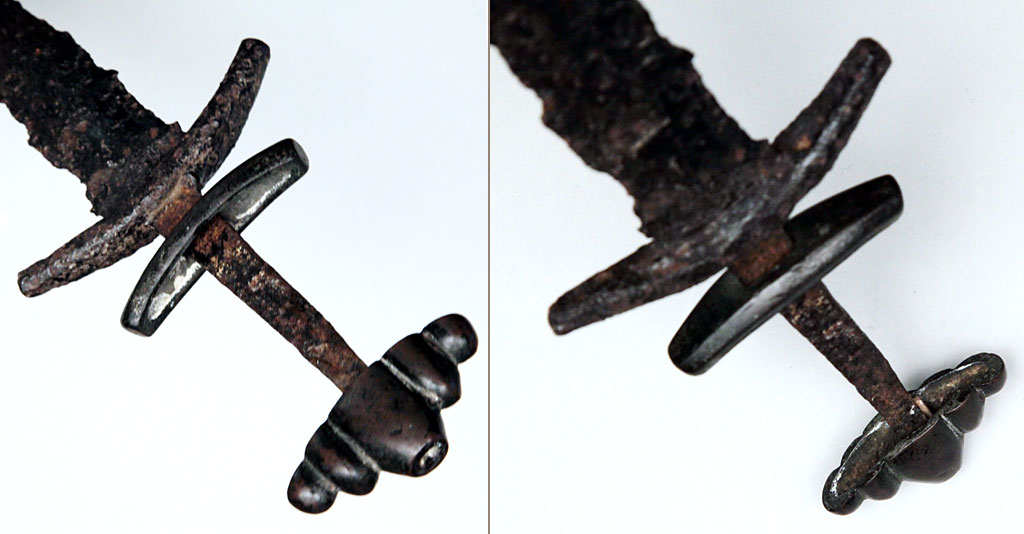










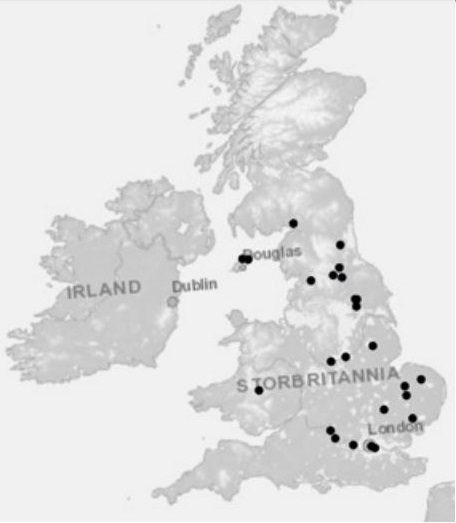
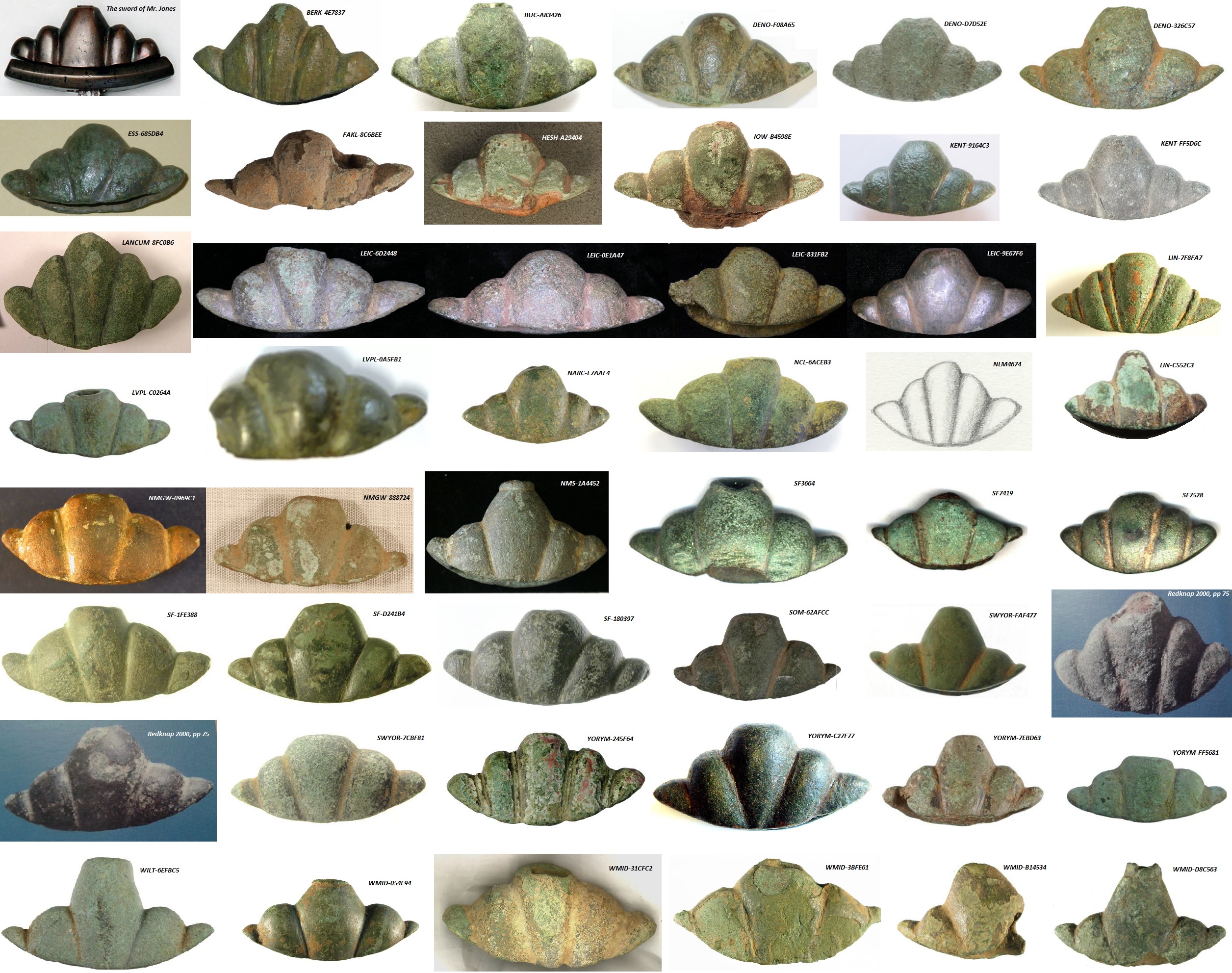
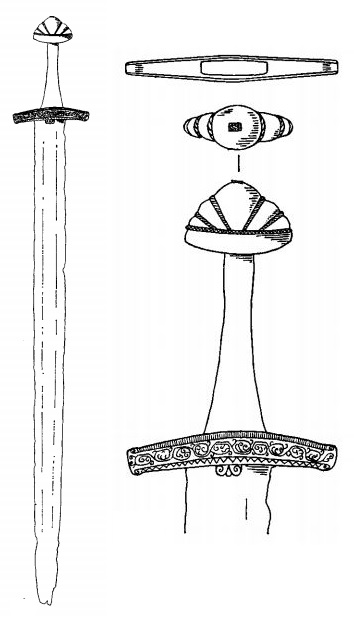

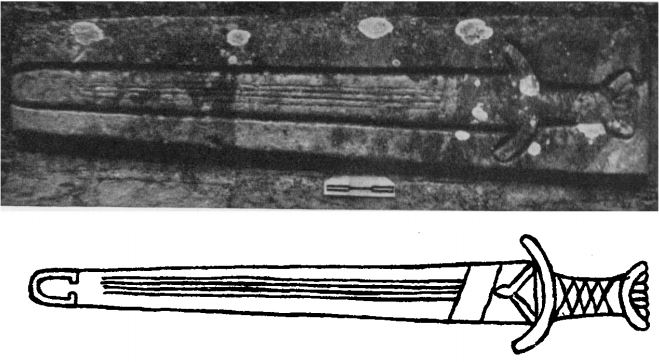
3 responses
Thank you for this really interesting article. Last weekend I was fortunate to recover a matching pommel to the south of Billingshurst in West Sussex, now registered with the PAS as SUR-FAB3D9. Your article has greatly added to my knowledge on this item.
Kind regards
Andy
Dear Andy,
that is a superb information! Could you please send me some pictures?
Thank you for letting me know!
Best regards
Thomas
Dear Andy,
I was able to find your piece at PAS website and I added it to my catalogue. Thank you!
Best regards
Thomas